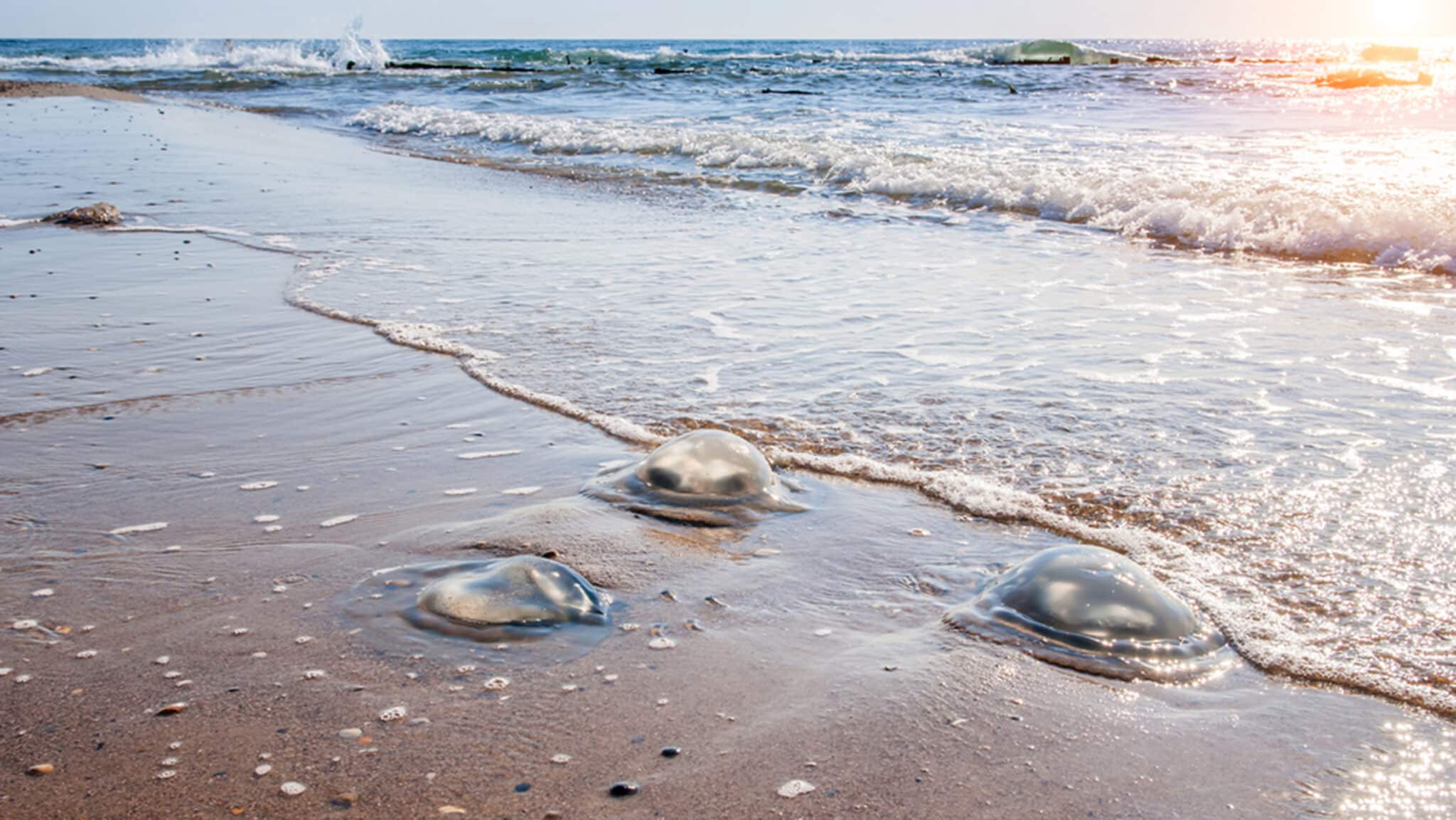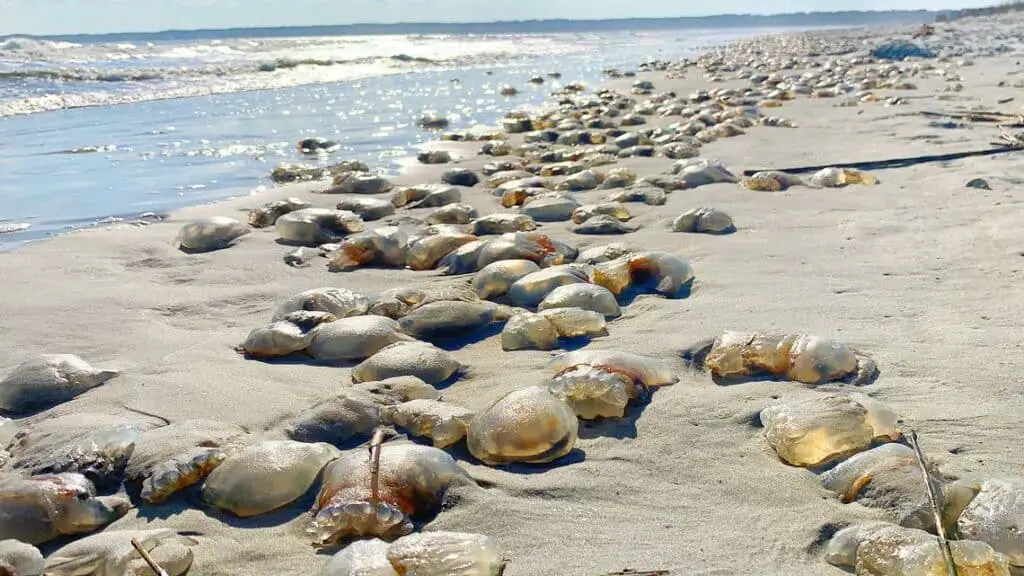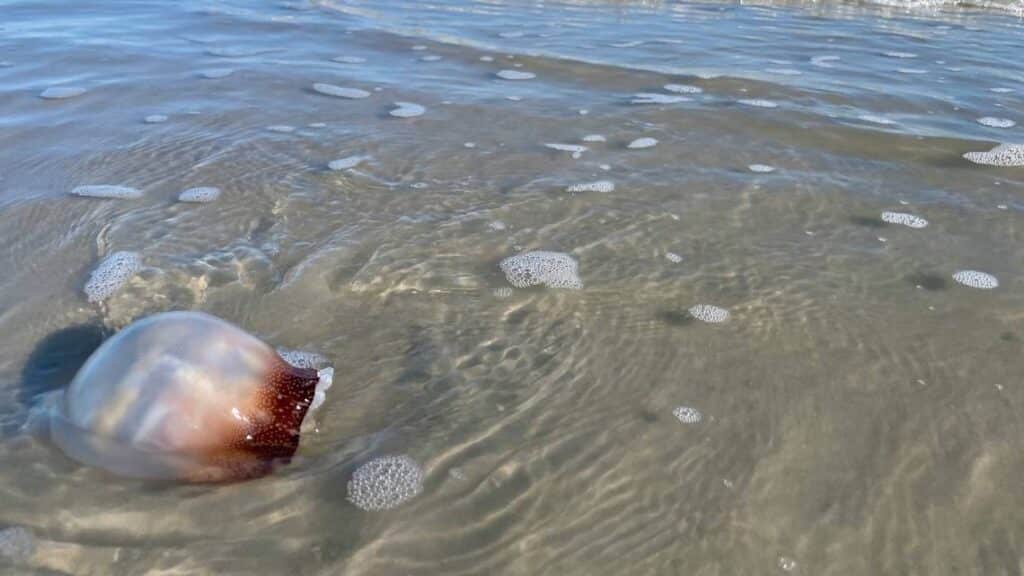Why Do Jellyfish Come To Shore

Introduction
Why Do Jellyfish Come To Shore: Jellyfish are fascinating creatures that have puzzled marine biologists and beachgoers alike for generations with their enigmatic habit of washing up on shorelines around the world. While these gelatinous organisms are primarily known for their graceful movements beneath the ocean’s surface, their occasional ventures onto the beach have raised numerous questions about their behavior and the underlying reasons for this seemingly unusual phenomenon.
This phenomenon of jellyfish coming to shore, often referred to as a “jellyfish stranding” or “jellyfish bloom,” occurs sporadically in various coastal regions worldwide. It is characterized by the sudden and mass appearance of jellyfish individuals on beaches, where they may be found stranded, sometimes in significant numbers. This event can be a captivating spectacle for beachcombers and a cause for concern for coastal communities.
Understanding why jellyfish come to shore is essential for several reasons. First, it can provide insights into the complex interactions between marine ecosystems, environmental factors, and jellyfish populations. Second, it has practical implications for coastal management and public safety, as large jellyfish blooms can disrupt recreational activities and pose potential hazards. Finally, it sheds light on the broader field of marine biology and ecology, contributing to our knowledge of the delicate balance within our oceans.
We will delve into the multifaceted aspects of this intriguing phenomenon, examining the various factors and hypotheses that scientists have put forth to explain why jellyfish come to shore. From environmental influences to reproductive strategies, this investigation aims to unravel the mysteries behind this captivating behavior of these ancient and captivating marine creatures.

Why do jellyfish end up on the shore?
They float with the current, which means that if the current comes to shore, jellyfish may come too. Stormy weather and strong winds can also bring jellyfish to shore, and they can end up on the beach. Because they contain so much water, Jellyfish die quite fast after they wash up on a beach.
Jellyfish end up on the shore due to a combination of factors, primarily driven by environmental influences and their own biological strategies. Firstly, ocean currents and tides can carry jellyfish towards the coastline. These movements are often influenced by weather patterns, wind direction, and changes in water temperature, causing jellyfish to wash ashore in larger numbers during certain conditions.
Jellyfish exhibit various reproductive strategies that can lead them to the shore. Some species release their eggs and sperm into the water column, where fertilization occurs. The resulting larvae may be carried by currents towards shallower waters, including the coastline. Additionally, adult jellyfish often release tiny juvenile jellyfish near the shore, which can contribute to their presence on the beach.
Fluctuations in prey availability and competition for resources can lead jellyfish to follow the movements of their preferred food sources, which may bring them closer to the shore.
Jellyfish coming to the shore is a complex interplay of environmental factors, reproductive strategies, and ecological dynamics. While it continues to intrigue scientists and beachgoers alike, a deeper understanding of these mechanisms is crucial for both ecological research and coastal management practices.
Are jellyfish dead when they wash up on shore?
As soon as the jellyfish is dropped on the beach by the retreating tide, the jellyfish begins to die. A jellyfish breathes by taking in oxygen from the seawater through its skin so as soon as it is on dry land it can no longer live.
When jellyfish wash up on shore, they may appear lifeless, leading many to assume they are dead. However, the reality is more nuanced. Jellyfish are delicate, gelatinous creatures that can easily become stranded due to various factors, but they are not necessarily deceased upon arrival on the beach.
Jellyfish lack a centralised nervous system, a brain, or a circulatory system like vertebrate animals, which can make determining their state of life or death more challenging. Instead, they rely on a simple nerve net and contractile cells to move and capture prey.
When stranded on the shore, jellyfish can become stressed due to exposure to air, temperature changes, and physical damage from waves and beachgoers. This stress can lead to a state of shock or immobilization, causing them to lose their typical swimming and stinging abilities.
In many cases, if returned to the water promptly, jellyfish can rehydrate, regain their buoyancy, and continue their life cycle. Some species of jellyfish are even capable of regeneration, where a damaged or fragmented individual can grow into a new organism under favorable conditions.
So, while stranded jellyfish may appear lifeless, it’s essential to handle them with care and consider the possibility that they might revive if returned to the ocean swiftly. This emphasizes the importance of responsible beachcombing practices that prioritize the well-being of marine life.
Why do jellyfish get stranded on beach?
Jellyfish are not strong swimmers and so at times,have not choice but to follow prevailing currents and winds. An onshore wind can literaly blow hapless jellyfish onto the beach. These By-the-Wind Sailors are named very appropropriately. They literally have a sail but no fins or tail to propel themselves.
Jellyfish often get stranded on beaches due to a combination of natural and human-related factors. One primary natural factor is ocean currents and tides. Jellyfish are passive drifters, relying on currents for movement. Sometimes, these currents can carry them closer to the shoreline, where they become trapped by receding tides or turbulent waves.
Environmental conditions, such as wind patterns, water temperature changes, and the availability of prey, can also influence jellyfish movement. If food sources are concentrated near the coast, jellyfish may follow, increasing the likelihood of stranding.
Human activities can exacerbate this phenomenon. Pollution, including plastic debris and chemicals, can disrupt the natural movements of jellyfish and lead them to become stranded. In addition, coastal development can alter water flow and disrupt the habitats where jellyfish thrive.
Beachgoers can unintentionally contribute to jellyfish strandings. Walking or swimming near jellyfish can cause them stress or injury, leading to their immobilization on the beach. In some cases, people may deliberately remove jellyfish from the water, thinking they are helping, but this can disrupt their natural behaviors and life cycles.
Can a dead jellyfish sting you?
Jellyfish can sting if they brush against you when you’re swimming in the ocean. You also can get stung if you step on a jellyfish, even a dead one. Usually, jellyfish stings will hurt, but are not emergencies. Most cause pain, red marks, itching, numbness, or tingling.
Jellyfish stings occur when live jellyfish release toxins from specialized cells called nematocysts, typically found in their tentacles. These nematocysts are used for capturing prey and defending against potential threats. When a live jellyfish comes into contact with a person, the nematocysts can release venomous stinging cells, causing pain, itching, and other symptoms.
Once a jellyfish dies, however, its nematocysts are no longer active. The venomous cells lose their potency, and they cannot deliver a sting. Nevertheless, it’s crucial to handle dead jellyfish with care, as some species may still have residual toxins on their tentacles, which can irritate the skin upon contact. It’s advisable to use protective gear or a tool to safely remove dead jellyfish from the beach if necessary.
While a dead jellyfish may appear intimidating, it poses no risk of stinging you. The danger of jellyfish stings lies with live, actively swimming jellyfish. Caution should always be exercised when handling any marine life, living or dead, to minimise potential risks and protect the delicate balance of coastal ecosystems.
Why are there so many jellyfish in the ocean?
The abundance of jellyfish could be linked to a lack of predators, greater availability of nutrients, mild winters that allow for a longer breeding season, and so on. But sometimes there are huge jellyfish blooms that we are not so aware of, as they remain away from the beaches and stay in the open sea.
The proliferation of jellyfish in the ocean is influenced by a combination of ecological, environmental, and human-related factors. One significant factor is the adaptability of jellyfish species. They are highly resilient and can thrive in a variety of environmental conditions, including areas affected by pollution and temperature fluctuations.
Environmental changes can also play a role. Rising sea temperatures and altered ocean currents due to climate change can create favorable conditions for some jellyfish species, allowing them to expand their ranges and reproduce more prolifically.
Human activities can indirectly contribute to jellyfish population increases. Overfishing, for example, can reduce the number of natural jellyfish predators, such as sea turtles and certain fish species, which can lead to a surge in jellyfish numbers. Additionally, pollution from agricultural runoff and industrial activities can introduce excess nutrients into coastal waters, leading to eutrophication.
Lastly, coastal development and the construction of artificial structures, such as marinas and ports, can provide substrates for jellyfish polyps to attach and grow, further contributing to their population growth.
The increase in jellyfish populations in the ocean is a complex phenomenon influenced by a combination of natural and human-induced factors. Understanding these dynamics is essential for effective marine conservation and management efforts.
Can stranded jellyfish be returned to the water?
Stranded jellyfish can often be safely returned to the water, and doing so can be beneficial for both the jellyfish and the marine ecosystem. When jellyfish wash up on shore, they may appear lifeless or immobilized, but they are not necessarily dead. They can sometimes be in a state of shock due to exposure to air, temperature changes, or physical stress from waves and beachgoers.
Returning stranded jellyfish to the water promptly can help them rehydrate, regain buoyancy, and recover from their stressed state. If they are still alive, they may resume their normal swimming and feeding activities. Additionally, some species of jellyfish are capable of regeneration, so even if a part of them is damaged, they may recover and grow into a new organism when returned to suitable water conditions.
However, it’s essential to handle stranded jellyfish with care to avoid getting stung, as their nematocysts (stinging cells) may still be active. It’s advisable to use a tool like a piece of cardboard or wear gloves to gently lift and place the jellyfish back into the water without touching their tentacles.
Overall, returning stranded jellyfish to the water is a responsible and compassionate approach that can help preserve these fascinating marine creatures and maintain the balance of coastal ecosystems.
Can climate change affect jellyfish strandings?
Climate change can have a significant impact on jellyfish strandings. Climate change leads to a variety of environmental shifts that can influence the behaviors and distribution of marine species, including jellyfish.
Warmer Ocean Temperatures: Rising sea temperatures due to climate change can create more favorable conditions for certain jellyfish species. Warmer waters can extend the jellyfish breeding season and lead to higher reproduction rates, potentially resulting in larger jellyfish populations.
Altered Ocean Currents: Climate change can disrupt ocean currents and patterns, affecting the movement of jellyfish. Changes in currents can carry jellyfish closer to shore, increasing the likelihood of strandings.
Nutrient Pollution: Increased temperatures and altered rainfall patterns can promote nutrient runoff into coastal waters. Nutrient-rich waters can lead to eutrophication, creating ideal conditions for the growth of phytoplankton, which serves as a primary food source for jellyfish. This can lead to jellyfish blooms and subsequent strandings.
Ocean Acidification: Climate change also contributes to ocean acidification, which can impact the availability of prey for jellyfish. Some jellyfish species are less sensitive to changes in acidity than their competitors, giving them a competitive advantage.
Climate change can exacerbate factors that contribute to jellyfish strandings, such as temperature fluctuations, altered currents, and changes in food availability. As our climate continues to change, understanding these interactions is vital for predicting and managing the consequences of increased jellyfish strandings in coastal areas.
Do jellyfish intentionally come to shore?
Their movements are primarily influenced by environmental factors, such as ocean currents, tides, and water temperature, rather than conscious decisions or intentions.
Jellyfish are passive drifters, relying on the flow of water to carry them along. When they are carried closer to the shoreline by currents or tides, they can become stranded on the beach due to receding waters or turbulent waves. This stranding is a result of their inability to actively swim against the flow or escape unfavorable conditions.
Additionally, while jellyfish do exhibit behaviors related to their life cycles, such as mating and releasing young jellyfish into the water, these actions are driven by biological imperatives rather than a deliberate choice to come to shore. For example, some species release their eggs and sperm into the water, where fertilization occurs. The resulting larvae may be carried by currents towards shallower waters, including the coastline, but this is part of their natural reproductive strategy.
Jellyfish strandings on the shore are primarily a consequence of natural processes and environmental factors, rather than a deliberate decision or intention on the part of the jellyfish.

Conclusion
The phenomenon of jellyfish coming to shore, though enigmatic, has yielded valuable insights into the intricate dynamics of marine ecosystems and the behavioral patterns of these captivating creatures. As we explored the various factors contributing to this intriguing behavior, several key conclusions emerge.
Environmental factors, such as ocean currents, temperature changes, and tides, play a significant role in driving jellyfish to the shore. Their movements are not arbitrary but rather a response to a combination of these factors, making jellyfish stranding a complex and occasionally predictable event.
Jellyfish blooms on the shoreline are not solely a matter of inconvenience for beachgoers; they have ecological implications as well. These occurrences offer a glimpse into the delicate balance of marine life, where fluctuations in jellyfish populations can influence the broader marine food web.
Reproductive strategies, such as mass spawning and the release of young jellyfish near the shoreline, also contribute to this behavior. Evolution has equipped jellyfish with strategies that maximize their chances of survival and reproduction.
Understanding why jellyfish come to shore remains an ongoing area of research, as the interactions between these gelatinous creatures and their environment are multifaceted and intricate. Continued scientific investigation will shed further light on this phenomenon and its implications for both marine ecosystems and coastal communities.
The quest to comprehend why jellyfish come to shore highlights the complexity and interconnectedness of life in our oceans. It underscores the need for ongoing research and conservation efforts to protect these vital ecosystems and the mysterious inhabitants that inhabit them.



